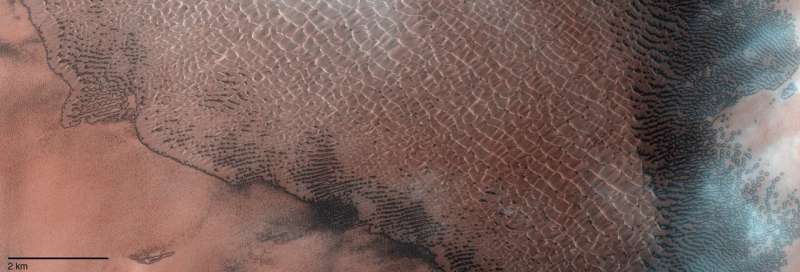Image: Lomonosov crater on Mars

At first glance this captivating scene peering through wispy clouds and down onto a dune field is reminiscent of a satellite view of one of Earth's deserts, but this is in fact a beautiful landscape on Mars.
This spectacular dune field sits in the center of Lomonosov crater, deep in the northern hemisphere of Mars (65ºN, 351ºE). It was imaged by the CaSSIS camera on the ESA-Roscosmos ExoMars Trace Gas Orbiter (TGO) on 2 December, 2020. The image was taken as part of a campaign to track the evolution of the dune field throughout the year.
At this time, northern winter was coming to an end on Mars and the frost over these areas had begun to sublimate. The darker spots indicate areas where frost has sublimated and the darker basaltic sand is visible. The crests of the dunes indicate the average wind direction, in this case, the wind comes predominantly from the bottom left to the top right of the image. To the right, darker, more basaltic rich and frost-free sediments are visible. It is also in the right of the image that bright white clouds stand out against the darker sediments on the ground.
The image was released on the occasion of the five year launch anniversary of the mission.
The first five years
TGO launched from the Baikonur Cosmodrome in Kazakhstan on 14 March 2016, arriving at Mars seven months later. It spent several months aerobraking—using the top of the planet's atmosphere to create drag and slow down—to became the first ESA spacecraft used to enter its science orbit in this way.
The mission began full science operations in April 2018 with its suite of four instruments. TGO's NOMAD and ACS spectrometers are designed to provide the best ever inventory of the planet's atmospheric gases yet, and have already detected a new gas—hydrogen chloride—for the first time, as well as studying processes linked to atmospheric water escape in greater detail than ever. TGO is also adding to the lively debate surrounding the presence of methane on the planet by revealing a surprising lack of the mysterious gas. The FREND instrument is mapping the distribution of hydrogen in the uppermost meter of the planet's surface, creating a detailed map of possible water-rich oases, relevant for future exploration of Mars. The CaSSIS camera has captured more than 20 000 images documenting the surface and complementing the data returned by the other instruments to help characterize features that may be related to trace gas sources.
TGO also provides routine data relay for NASA's landers and rovers: Opportunity (until its end of operations in 2018), Curiosity, Insight and Perseverance. It will also be the communication link for the second ESA-Roscosmos ExoMars mission, comprising the Rosalind Franklin rover and Kazachok platform, when it arrives on Mars in 2023.
Provided by European Space Agency





















